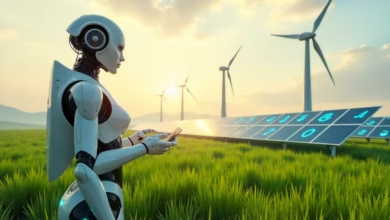AI Tools for Eco-Friendly Workplace Practices: Cutting Carbon in 2025

Think about a regular workday. Lights stay on longer than needed, laptops hum all night, and meetings drag on with cameras running. These small habits add up to big emissions. In 2025, AI tools for eco-friendly workplace practices are no longer just futuristic ideas—they’re practical ways to save energy, cut waste, and work more sustainably.
This article explores how businesses and individuals can use artificial intelligence and mindful habits to shrink their workplace carbon footprint without hurting productivity.
Why Carbon Reduction at Work Is Crucial
- Environmental urgency: Offices, home work setups, and business travel together create significant emissions.
- Economic sense: Lower power bills and reduced hardware strain mean real financial savings.
- Brand and culture: Employees and customers increasingly value companies that prioritize sustainability.
- Policy pressure: Governments and investors now track environmental performance more closely.
Where AI Makes the Biggest Difference
1. Smarter Energy Use
AI systems connected to sensors can learn patterns—when rooms are empty, when heating or cooling isn’t needed—and make instant adjustments. Some tools predict energy spikes and act before waste occurs.
2. Better Scheduling for Remote Work
AI-powered calendars can group meetings efficiently, minimize idle screen time, and even suggest when to go offline. By aligning with greener energy grid times, teams indirectly reduce emissions.
3. Leaner Computing
Cloud platforms driven by AI can scale servers up or down automatically. Instead of leaving machines running idle, resources adjust in real time. This not only saves energy but also reduces costs.
4. Cutting Back on Travel
AI route planners and carbon calculators help decide whether a trip is worth the emissions—or whether a virtual meeting works just as well. Companies can set smart policies using these insights.
5. Encouraging Green Habits
AI apps that show personal energy use or a team’s collective carbon savings help keep sustainability visible. Turning progress into a game motivates people to take part.
Tools Worth Considering
- JouleX Energy Manager – automates energy savings across devices.
- SwitchBot with AI dashboards – adapts lighting and heating to occupancy.
- Climatiq API – calculates emissions from everyday work activities.
- Green cloud tools – pick renewable-powered servers and optimize usage.
- DeepMind AI for cooling – proven to cut data center energy by double digits.
Steps to Build a Greener Workplace
- Start with a review: Measure where your office or home setup wastes the most.
- Set targets: For example, cut travel by 20% or reduce idle device time by half.
- Apply small fixes first: Sleep settings, efficient scheduling, greener cloud choices.
- Layer AI tools next: Add automation where the biggest waste exists.
- Engage people: Share results and reward teams for sustainable actions.
- Keep checking progress: Review data, improve policies, adapt when needed.
Common Hurdles
- Initial setup cost: Begin with affordable or free solutions and scale later.
- Privacy worries: Use anonymized data to protect staff habits.
- Too much tracking: Focus on key numbers, not endless metrics.
- System compatibility: Pilot in small areas before large rollouts.
- Greenwashing risk: Be honest—report real savings, not exaggerated claims.
Real-World Wins
- A Swedish tech firm cut heating and cooling use by 30% using AI-driven building controls.
- A remote company reduced emissions by 25% after adopting AI scheduling that avoided unnecessary travel.
- Universities choosing renewable-powered cloud platforms halved their research computing emissions.
Workplace sustainability doesn’t have to be complicated. With AI tools for eco-friendly workplace practices, small changes—like smarter scheduling, efficient devices, or cleaner cloud choices—can create meaningful impact.
It’s not about perfection but about progress. Start with one step, measure the results, and let AI handle the repetitive adjustments. In the end, greener work habits not only protect the planet but also make daily work life smoother and more cost-effective.
For similar articles, please visit: AI in Environment & Sustainability
Homepage / humanaifuture.com




